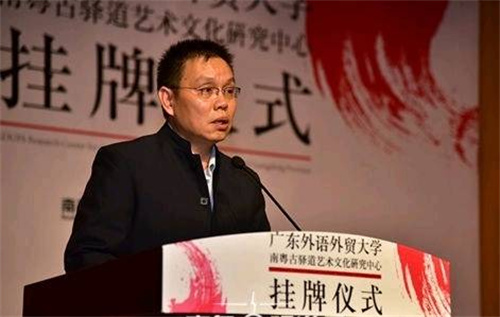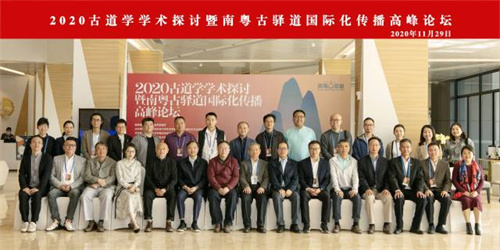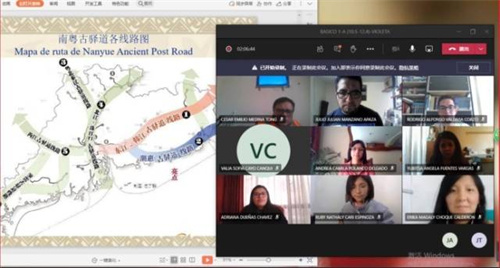"The ancient postal road sings, the girls of Zhanglin dress beautifully. Husbands in attire head for official duties, wearing straw s an umbrella in the rain. Returning on a white horse adorned with a golden saddle..." This popular folk song from southern Guangdong, known as "One Road, One Children's Song," is based on the Shantou children's song "Lady Moon in the Moonlight." The mention of "Zhanglin Port" in the lyrics is a commemorative location along The South Guangdong ancient post road, serving as one of its seaports."

Li Zhigang
Recently, Professor Li Zhigang, the director of the South Guangdong Ancient Post Road Art and Culture Research Center at Guangdong University of Foreign Studies, expressed in an interview with Southern + reporters that the historical relics, cultural landscapes, and natural scenery along the South Guangdong Ancient Post Road provide a unique foundation for the development of cultural tourism.
Research on the music of the South Guangdong Ancient Post Road can contribute a distinctive charm to cultural tourism, attracting more visitors and fostering the growth of the local cultural and tourism industry.
In recent days, the office of the Talent Work Leading Group of the Shantou Municipal Committee of the Communist Party of China has actively promoted the "Chaoji Mingjia" (Outstanding Talents from Chaozhou)series of performance events. The South Guangdong Ancient Post Road Art and Culture Research Center at Guangdong University of Foreign Studies has also actively participated in these efforts, making contributions to the promotion of excellent traditional Chinese culture and serving the cultural development of the local area.
The Ancient Guangdong Postal Road and Cross-Cultural Exchange
The South Guangdong Ancient Post Road refers to the network of routes used for transmitting documents, transporting goods, and facilitating the movement of people within Guangdong before 1913. This comprehensive system includes both water and land routes, official roads, and ancient pathways, playing a vital role in economic exchange and cultural dissemination.
Professor Li Zhigang explains that the migration of ancient people led to the collision and integration of Guangfu culture, Hakka culture, Hoklo culture, and Central Plains culture. These cultural influences are reflected in the villages along The South Guangdong Ancient Post Road, impacting local arts, music, crafts, and architecture. Studying the modes of cultural inheritance, historical transmission, as well as the social status and values within rural communities is essential.
At significant nodes along The South Guangdong Ancient Post Road, such as Guangzhou Huangpu Ancient Port, Shantou Overseas Chinese Memorial Site, Taishan Haikou Port, and Xuweng Haiyushi Starting Port, cross-cultural exchanges are evident in religion, architecture, clothing, cuisine, etiquette, and folk customs.
The culture of the South Guangdong Ancient Post Road is a unique and splendid cultural heritage formed over the long history of the Guangdong region. The major routes and nodes cover three major cultural systems of Guangdong: Guangfu culture, Chaoshan culture, and Hakka culture. Additionally, it encompasses Leizhou culture and Gaoliang culture. In its development, the South Guangdong Ancient Post Road has generated a series of outstanding traditional Chinese cultural legacies.
The protection and utilization of the South Guangdong Ancient Post Road are important initiatives for Guangdong Province to strengthen the preservation of historical and cultural cities, inherit outstanding traditional culture, highlight local characteristics, continue historical context, and build cultural confidence and identity.
Since 2016, Guangdong Province has actively promoted the protection, restoration, and revitalization of the South Guangdong Ancient Post Road, achieving significant.
According to Li Zhigang's introduction, the South Guangdong Ancient Post Road has undertaken extensive exploration in revitalization and utilization efforts, particularly in fostering the prosperity of rural culture and rejuvenating the cultural atmosphere in villages. Special emphasis has been placed on inheriting and developing outstanding traditional rural culture. The preservation of the historical and cultural protection line surrounding the South Guangdong Ancient Post Road has been prioritized. Key protection measures have been implemented for cultural relics, traditional villages, ethnic villages, traditional buildings, agricultural relics, and more along various routes of the South Guangdong Ancient Post Road.
Initiatives such as "Cultural and Creative Competitions," "Orientation Competitions," "Post Road Study Tours," "Nursery Rhymes Along the Way," and other projects have been launched to promote the new development of rural culture. These efforts aim to directly or indirectly support the inheritance and development of outstanding local opera and traditional performing arts, ethnic cultures, and folk cultures in rural areas.
The overseas dissemination of the South Guangdong Ancient Post Road

Event Photos
Guangdong University of Foreign Studies (GDUFS) is a key university in the construction of high-level universities in Guangdong Province. With distinctive international features, the university is an important base for international talent training, foreign language and literature, global economic governance, foreign-related rule of law research and international dissemination of Chinese culture in South China.
In 2019, the Research Centre for Art and Culture of the South Guangdong Ancient Post Road of Guangdong University of Foreign Studies was established.
Li Zhigang told Nanfang+ that over the years, the Research Centre for Art and Culture of the Southern Guangdong Ancient Post Road has also taken advantage of the university's Confucius Institute to continuously explore the international dissemination of Lingnan culture of the South Guangdong Ancient Post Road.
The Confucius Institute at Sapporo University in Japan, the Confucius Institute at Ural Federal University in Russia, the Confucius Institute at Universidad Católica de Santa María in Peru, the Confucius Institute at the University of Cape Verde, the Confucius Classroom at the University of Ain Shams in Egypt, and the Confucius Institute at the University of Porto in Portugal have jointly organized activities with the Research Centre for the Art and Culture of the South Guangdong Ancient Post Road under the theme "Cultural and Academic Exchange and Promotion of the South Guangdong Ancient Post Road" to explore new ways to revitalize the South Guangdong Ancient Post Road. Under the theme of "Academic Exchange and Promotion of the Southern Guangdong Ancient Post Road", they have explored new ways to revitalize the South Guangdong Ancient Post Road. For example, the Confucius Institute at Ural Federal University in Russia has organized online activities for the academic exchange and promotion of the culture of the South Guangdong Ancient Post Road.

Online Course Screenshots
The Chinese teachers of the Confucius Institute made rich presentation materials, marked and focused on the explanations of some raw words. Based on the South Guangdong Ancient Stagecoach Route, they introduced the ancient Chinese stagecoach culture, information exchange system, Cantonese language, modern orienteering and cross-country activities of the Ancient Stagecoach Route, tourism in Guangdong, and culture of the villages and societies, systematically demonstrating the characteristics of the culture of Guangdong to Russian students and Chinese language enthusiasts. Russian friends learnt and sang songs such as "Moonlight" and "Ballad of the Post Road" together with the teachers.
Teacher Lin Yajun, a volunteer of Confucius Institute at Santa Maria Pontifical Catholic University of Peru, chose to introduce the South Guangdong Ancient Post Road through orienteering and cross-country sports. Volunteer teacher Yang Liu not only introduced the South Guangdong Ancient Post Road in detail in the form of photos and videos, but also extended it to the development opportunities of "One Belt, One Road".
Li Zhigang believes that through the platform of the Confucius Institute and by using the Nan Yue Ancient Post Road as a carrier of excellent traditional culture, Chinese history and excellent traditional culture can be further disseminated, and the story of the South Guangdong Ancient Post Road and China's story can be told well in an international perspective.
(The original article was published on "Nanfang Plus," compiled and edited by South China Historical Trail website. For any copyright or related issues, please contact theSouth China Historical Trail website.)
Editor-in-chief: He Luoxi